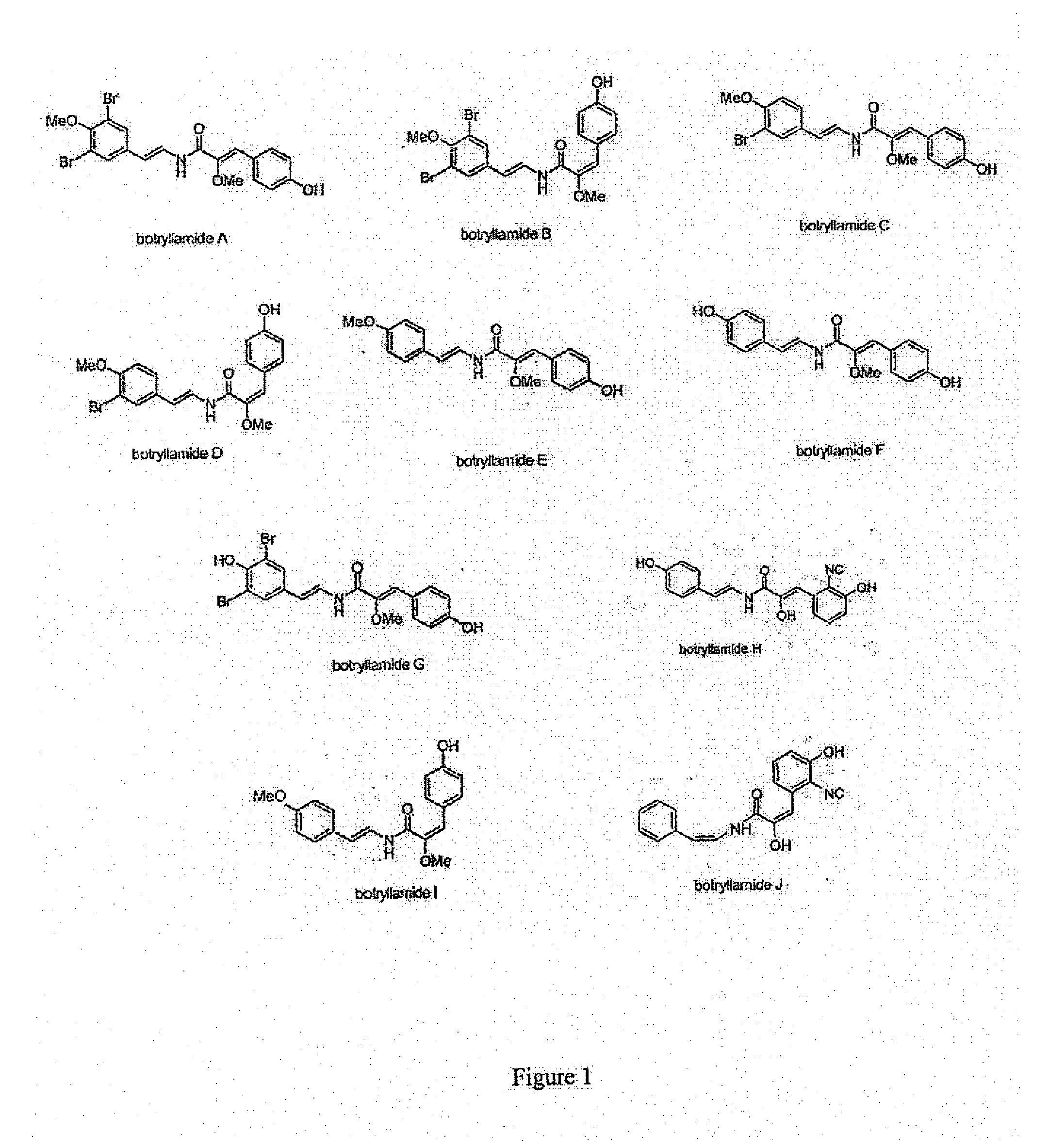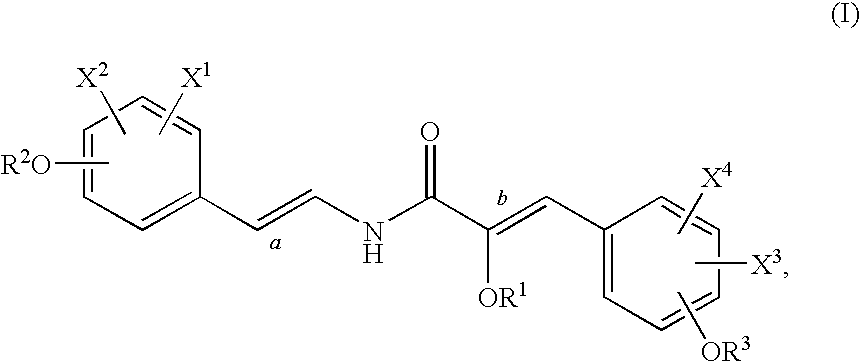Method of inhibiting abcg2 and other treatment methods
a technology of abcg2 and other drugs, applied in the direction of heterocyclic compound active ingredients, biocide, drug compositions, etc., can solve the problems of few, if any, clinically useful inhibitors of abcg2 activity, and achieve the effects of reducing the drug resistance of a chemotherapeutic agent, enhancing the bioavailability of an abcg2 substrate drug, and enhancing the chemotherapeutic treatment of tumor cells
- Summary
- Abstract
- Description
- Claims
- Application Information
AI Technical Summary
Benefits of technology
Problems solved by technology
Method used
Image
Examples
example 1
[0094]This example illustrates a method of isolating botryllamides in accordance with an embodiment of the invention. The marine ascidian Botryllus tyreus (75.5 g wet weight) is sequentially extracted with 1:1 CH2Cl2-MeOH and 100% MeOH. Evaporation of the solvents under reduced pressure provides 4.8 g of crude extract. A 3 g aliquot of the extract is dissolved in 90% aq. MeOH and then extracted with n-hexane. The aqueous MeOH fraction is further diluted with H2O to provide a 60% aq. MeOH solution, which is then partitioned with CH2Cl2. The bioactive CH2Cl2 fraction is separated by ODS (C18) flash chromatography eluted with a step gradient of 1:1 MeOH—H2O, 4:1 MeOH—H2O and 100% MeOH. Final purification by ODS HPLC elutes with a linear gradient from 20% CH3CN-80% H2O to 70% CH3CN-30% H2O over 50 minutes afforded botryllamide A (110 mg), botryllamide B (3.5 mg), botryllamide C (29 mg), botryllamide D (2.5 mg), botryllamide E (58 mg), botryllamide F (1.2 mg), botryllamide G (9 mg), botr...
example 2
[0095]This example demonstrates a screening assay for ABCG2 inhibitors in accordance with an embodiment of the invention.
[0096]Accumulation of pheophorbide a, a fluorescent ABCG2 substrate (Jonker et al., Proc. Natl. Acad. Sci. USA, 99: 15649-54 (2002) and Robey et al., Cancer Res., 64: 1242-6 (2004)), formed the basis of the assay for inhibitors of ABCG2 activity (Henrich et al., J. Biomol. Screen, 11: 176-83 (2006)). Briefly, NCI-H460 / MX20 cells are transferred to black wall, clear bottom 384-well polylysine-coated assay plates (Corning, Corning, N.Y.) and allowed to attach for several hours. Pheophorbide a (1 μM final concentration) is added immediately followed by compounds or vehicle (DMSO / PBS) control and incubated an additional 18 h. After removal of medium and washing with PBS containing Ca2+ and Mg2+, fluorescence intensity is read on a Tecan Safire fluorescence plate reader in bottom read mode, 395 nm excitation, and 670 nm emission. Each plate has control wells containing...
example 3
[0098]This example demonstrates an assay to determine the ability of compounds to sensitize cancer cells to killing by mitoxantrone in accordance with an embodiment of the invention.
[0099]The ability of compounds to sensitize NCI-H460 / MX20 cells to killing by mitoxantrone is assessed as described in Henrich et al. (J. Biomol. Screen, 11: 176-83 (2006)). ABCG2 over-expressing cells or parental cells are treated with mitoxantrone in the presence or absence of 10 μM compound (or 1 μM FTC) and cell numbers assessed after 2 d by an XTT assay (Scudiero et al., Cancer Res., 48: 4827-33 (1988)). Final DMSO concentration is 0.2% (v / v). Compounds in accordance with an embodiment of the invention can inhibit ABCG2-mediated transport using BODIPY-prazosin as a substrate. For details of the test, see Robey et al., Br. J. Cancer, 89: 1971-8 (2003). This example also demonstrates that exemplary compounds inhibit MRP1-mediated calcein efflux (Robey et al., 2003, vide supra and Alvarez et al., Mol. ...
PUM
| Property | Measurement | Unit |
|---|---|---|
| body weight | aaaaa | aaaaa |
| wet weight | aaaaa | aaaaa |
| wet weight | aaaaa | aaaaa |
Abstract
Description
Claims
Application Information
 Login to View More
Login to View More - R&D
- Intellectual Property
- Life Sciences
- Materials
- Tech Scout
- Unparalleled Data Quality
- Higher Quality Content
- 60% Fewer Hallucinations
Browse by: Latest US Patents, China's latest patents, Technical Efficacy Thesaurus, Application Domain, Technology Topic, Popular Technical Reports.
© 2025 PatSnap. All rights reserved.Legal|Privacy policy|Modern Slavery Act Transparency Statement|Sitemap|About US| Contact US: help@patsnap.com



